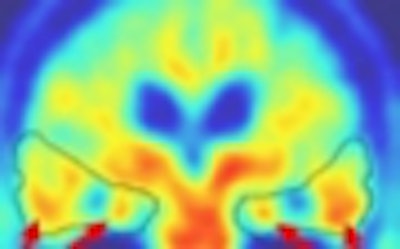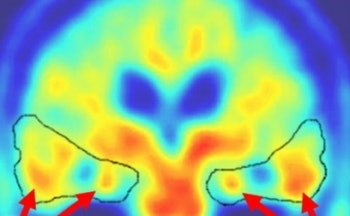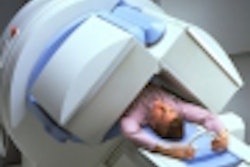
TORONTO - A PET study of a new radiopharmaceutical developed for imaging the early onset of Alzheimer’s disease was named Image of the Year by Dr. Henry Wagner Monday at the Society of Nuclear Medicine meeting.
The image was produced by a group of researchers at the UCLA School of Medicine. To create the image, the group, led by Jorge Barrio, Ph.D., created a new fluorine-based radiotracer that it believes could enable the diagnosis of Alzheimer’s before symptoms of the disease even appear.
The image demonstrates uptake of the tracer in ß-amyloid senile plaques and neurofibrillary tangles in the brain of an 82-year-old woman with Alzheimer’s disease. These plaques and tangles are the primary characteristic of Alzheimer’s.
 |
|
Red arrows indicate uptake of FDDNP in the plaques and tangles of the brain that are characteristic of Alzheimer's disease. Image courtesy of Jorge Barrio, PhD |
The name of the tracer is a mouthful: 2-(1-{6-[(2-[18F]fluoroethyl)(methyl) amino]-2-naphthyl}ethylidene)malononitrile, or (18F) FDDNP for short. Wagner believes that FDDNP could prove to be superior to FDG for imaging Alzheimer’s: FDG gives physicians a look at the metabolic activity caused after the onset of the disease, whereas FDDNP measures the actual cause of the pathology years before symptoms occur.
"This is a more direct expression of Alzheimer’s pathology than FDG-PET," Wagner said. "With this tracer, you may be able to get to the pathological process before it actually results in a measurable change in the blood flow."
Barrio’s group confirmed FDDNP’s findings through MR imaging of the patient, and also via in vitro digital autoradiography and fluorescence microscopy of brain tissue following the death of the patient. Wagner demonstrated several co-registered images showing the FDDNP study fused with images collected by the other techniques.
Barrio said the radiotracer is relatively easy to make by combining a precursor molecule to 18F. The group hopes to make the tracer available through the radiopharmaceutical distribution firm P.E.T.Net Pharmaceuticals. The group used an ECAT HR+ PET camera (Siemens Medical Solutions, Hoffman Estates, IL).
By Brian CaseyAuntMinnie.com staff writer
June 26, 2001
Click here to post your comments about this story. Please include the headline of the article in your message.
Copyright © 2001 AuntMinnie.com




















